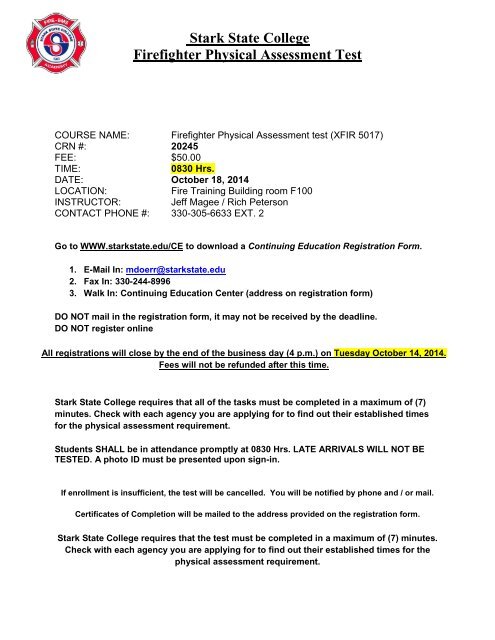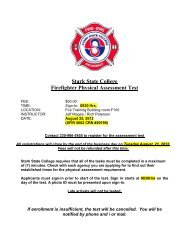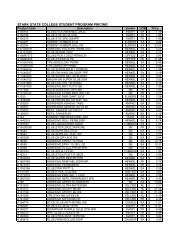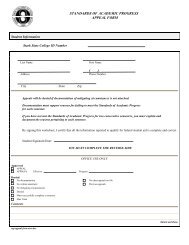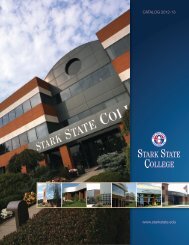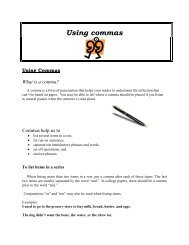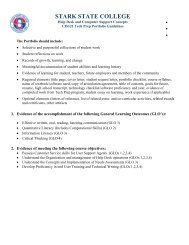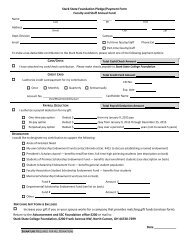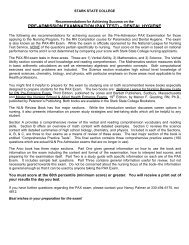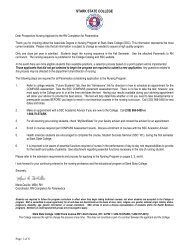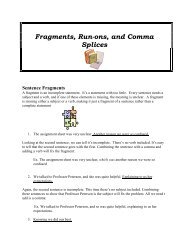Firefighter Physical - Stark State College
Firefighter Physical - Stark State College
Firefighter Physical - Stark State College
- No tags were found...
Create successful ePaper yourself
Turn your PDF publications into a flip-book with our unique Google optimized e-Paper software.
<strong>Stark</strong> <strong>State</strong> <strong>College</strong><strong>Firefighter</strong> <strong>Physical</strong> Assessment TestCOURSE NAME: <strong>Firefighter</strong> <strong>Physical</strong> Assessment test (XFIR 5017)CRN #: 20245FEE: $50.00TIME:0830 Hrs.DATE: October 18, 2014LOCATION:Fire Training Building room F100INSTRUCTOR:Jeff Magee / Rich PetersonCONTACT PHONE #: 330-305-6633 EXT. 2Go to WWW.starkstate.edu/CE to download a Continuing Education Registration Form.1. E-Mail In: mdoerr@starkstate.edu2. Fax In: 330-244-89963. Walk In: Continuing Education Center (address on registration form)DO NOT mail in the registration form, it may not be received by the deadline.DO NOT register onlineAll registrations will close by the end of the business day (4 p.m.) on Tuesday October 14, 2014.Fees will not be refunded after this time.<strong>Stark</strong> <strong>State</strong> <strong>College</strong> requires that all of the tasks must be completed in a maximum of (7)minutes. Check with each agency you are applying for to find out their established timesfor the physical assessment requirement.Students SHALL be in attendance promptly at 0830 Hrs. LATE ARRIVALS WILL NOT BETESTED. A photo ID must be presented upon sign-in.If enrollment is insufficient, the test will be cancelled. You will be notified by phone and / or mail.Certificates of Completion will be mailed to the address provided on the registration form.<strong>Stark</strong> <strong>State</strong> <strong>College</strong> requires that the test must be completed in a maximum of (7) minutes.Check with each agency you are applying for to find out their established times for thephysical assessment requirement.
The <strong>Firefighter</strong>’s <strong>Physical</strong> Assessment Test consists of thefollowing tasks over a timed course:TASK 1 - Stair Climb with High Rise PackCarry a high-rise standpipe pack (2-50 foot sections of 1 1/2-inch hose) to the fifth floor ofthe fire tower. Deposit the hose in the designated location. After Task 2 is completed,this hose will be returned down the stairs to the starting location.TASK 2 - Hose HoistFrom a fifth story roof, using a hand motion hoist a 50 foot donut roll of 2 1/2 inch hoseconnected by a rope.TASK 3 - Forcible EntryUsing the Keiser Force Machine and a shot filled sledge hammer drive the metal sled ofthe Keiser Force Machine a distance of five feet. Strike the end of the beam, contacting thesurface as squarely as possible for maximum force transfer. Pay attention to the position ofthe beam in relation to the instep of your foot - they should be on the same plane. Getting"ahead" of your self will result in the point of impact at the handle of the Force Machine asopposed to the head of the mallet. This event is complete when the leading edge of the sledis even with the tray. This completes the forcible entry event.TASK 4 - Hose AdvanceWalk the required distance of 140 feet to the next station. Grasp the end of the charged 13/4 inch hoseline and drag it 75 feet to the box where indicted. This completes the fourthevent.TASK 5 - Victim RescueWalk 30' to the next station and grasp the victim (165 pound manikin) around the chest anddrag it 100 feet. Place your chest as close as possible against the back of the dummy, lockyour fingers and hands and lift with your whole body. This event is complete when you andthe mannequin cross the finish line.<strong>Stark</strong> <strong>State</strong> <strong>College</strong> will mail a certificate of completion with the applicant’s time uponsuccessful completion of the test. The certificate will be mailed to the mailing address theapplicant indicates upon registration. The applicant will be responsible for taking theircertificate of completion to the jurisdiction for which they are applying. Applicants must besure that the fire departments where they are applying for a position will accept thecertificate as their standard.
Requirements for <strong>Firefighter</strong> <strong>Physical</strong> Assessment Testing1. Must show photo proof of identification. An Ohio Drivers License or <strong>State</strong> IdentificationCard is acceptable. A copy of the identification will be made to accompany theapplicant’s testing information.2. Must read and sign a waiver of liability.3. Must complete a college non-credit registration form and pay course fee prior to thetest date.4. Must be in excellent physical health. A physician’s exam is not required but is highlyrecommended.The firefighter’s agility testing will be conducted outdoors. Applicants will be required towear five-pound ankle weights to simulate the weight of firefighter turn out gear. An airtank will be worn during testing for weight only. Applicants MUST furnish their own gloves(mechanic, extrication, or leather gloves that provide good dexterity are appropriate). Afirefighter helmet must be worn. Applicants can furnish their own helmet or a helmet willbe provided. Applicants can bring their own liner, if they prefer. A ball cap or skullcap willwork. It is suggested that applicants wear physical training clothing to include long pantsand athletic shoes with good traction.Firefighting is physically demanding and at times extremely hazardous. Candidates areencouraged to do pre-testing exercises that will assist them in completing the agility test.TESTING DAY:Late arrivals will not be tested.Applicants must sign-in prior to start of the testA photo ID must be presented upon sign-in.Applicants will be briefed and a short video detailing the tasks required for thephysical agility test will be viewed before testing begins.Family and friends are not permitted in the testing area.Please note: <strong>Stark</strong> <strong>State</strong> <strong>College</strong> does not assume any responsibility for any medicalconsequences that might arise from participating in physical agility testing. Eachparticipant will be required to sign a waiver of liability.
History of The <strong>Firefighter</strong> ChallengeThe Challenge was born the day that Chief David Gratz, Director of Fire/Rescue Services, MontgomeryCounty, MD, walked into the Human Performance Laboratory at the Sports Medicine Center of theUniversity of Maryland in July, 1974. Present to greet him were Drs. Dotson, Santa Maria and Davis. ChiefGratz's interest was immediate - he needed a validated test. The mission: develop a physical ability test todetermine whether a job applicant had the requisite capabilities to perform the essential job functions of afirefighter.With US Fire Administration funding, the research design was laid out. It required the cooperation of firedepartments in seven Washington, DC, political jurisdictions, each providing a representative sample offirefighters proportionate to its relative size. Ultimately 100 randomly selected firefighters underwent abattery of fitness tests at the Human Performance Laboratory that included measures of cardiopulmonaryperformance and muscular fitness.Concurrent with the fitness tests and with the assistance of the Maryland Fire Rescue Institute (MFRI), Drs.Dotson and Davis designed a criterion task test (CTT) employing five commonly performed or highlycritical fireground evolutions. Each of the 100 firefighters performed the five tasks successively whilewearing full protective ensemble (including SCBA) "in the same manner as at the scene of a fire." After alltesting, the results of the laboratory fitness measures were statistically correlated against the CTTperformances. This landmark study demonstrated a high correlation between personal fitness and jobperformance. That was in 1976.In 1991, Dr. Davis hit upon an idea that would eventually become the Challenge. He had observed thecompetitive nature of firefighters during the initial testing back in 1976. So, he thought, "why not devise acompetition that would highlight the unique nature of the fire service and showcase the talents andcapabilities of firefighters." The CTT seemed the perfect "vehicle" for the task.In early 1991, he approached the Washington, DC, Council of Governments to get support for his idea,briefing the various fire chiefs on his concept for the competition. With their approval he worked with theFire Training Officer Sub-committee and came up with the rules for the competition. Everything was ready.Sunday, May 5, 1991, dawned bright and cool. Teams from five departments in the D.C. metropolitan areagathered at MFRI to christen what would become the <strong>Firefighter</strong> Combat Challenge. Quiet as church micewhile instructions and rules were given, the several hundred spectators erupted spontaneously as the firstcompetitor made his way to the top of the tower. The crowd's response told Davis that he was ontosomething. TV coverage and a four-page color story in Fire Chief magazine added credibility to the event.The first Challenge was won by Prince William County, VA, in a time of 10:08. Although that was the onlyevent that first year, the seeds of competition had been sown. The next year, 1992, with DuPont as thepresenting sponsor, saw seven competitions and the first truly national championship held during theInternational Association of Fire Chiefs' (IAFC) annual meeting in Anaheim, CA. The Casper FireDepartment took top honors.By 1993 the Challenge had expanded to twelve events spread across the nation. ESPN initiated its coverageof the Challenge at the National Championship, the first-ever indoor competition. The Championship, heldin Dallas, TX, during the annual IAFC meeting, was won, again, by Casper.
Reference XFIR 5017


